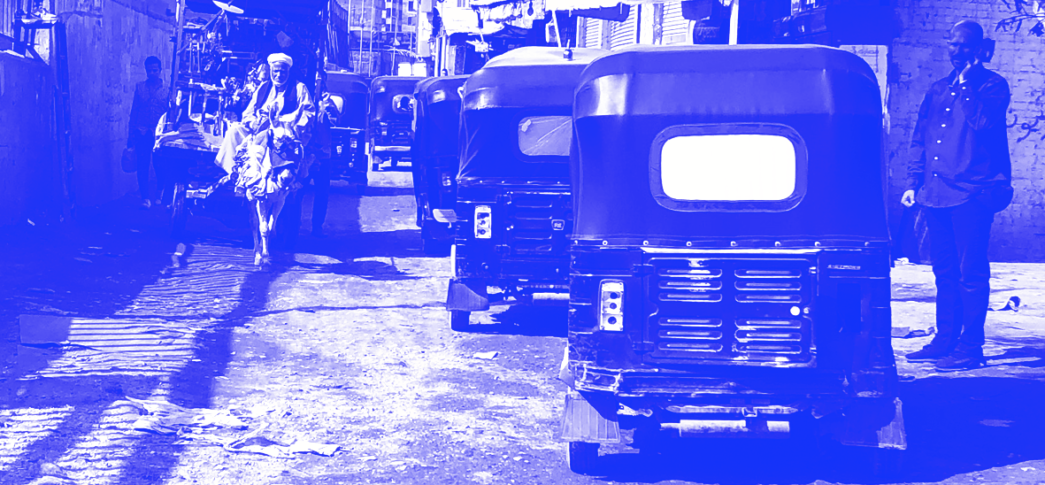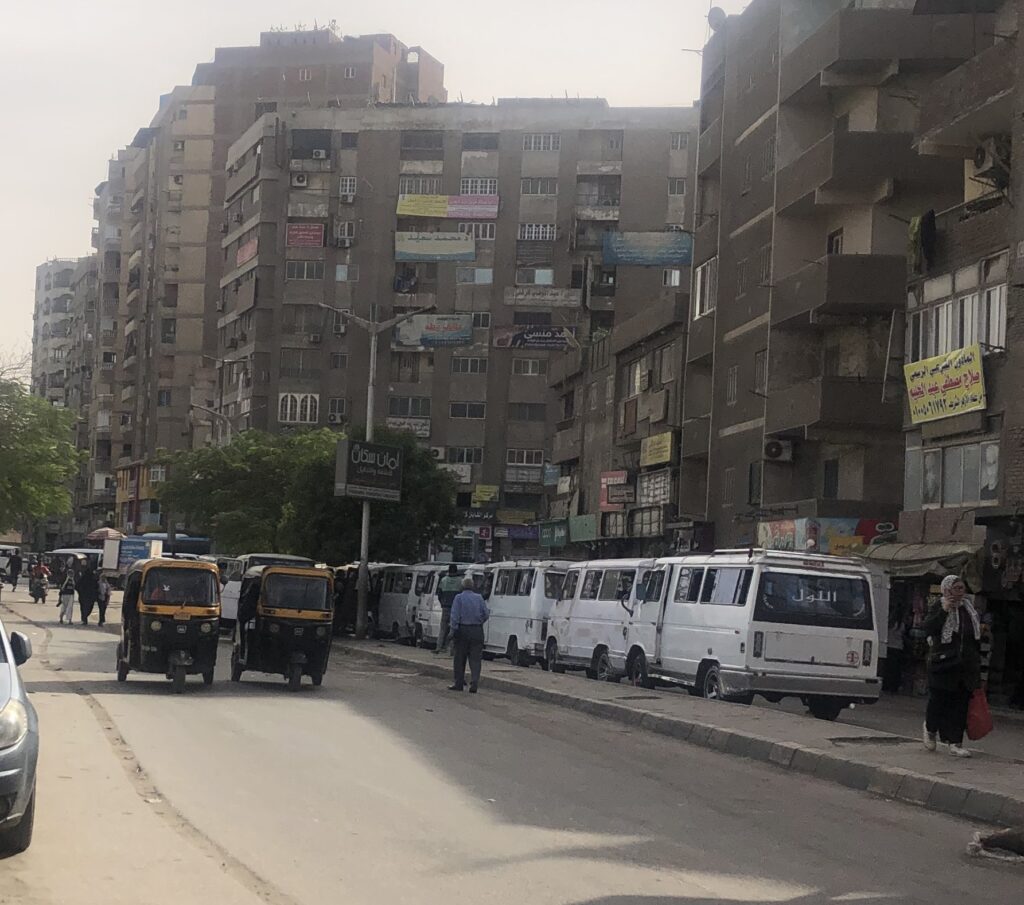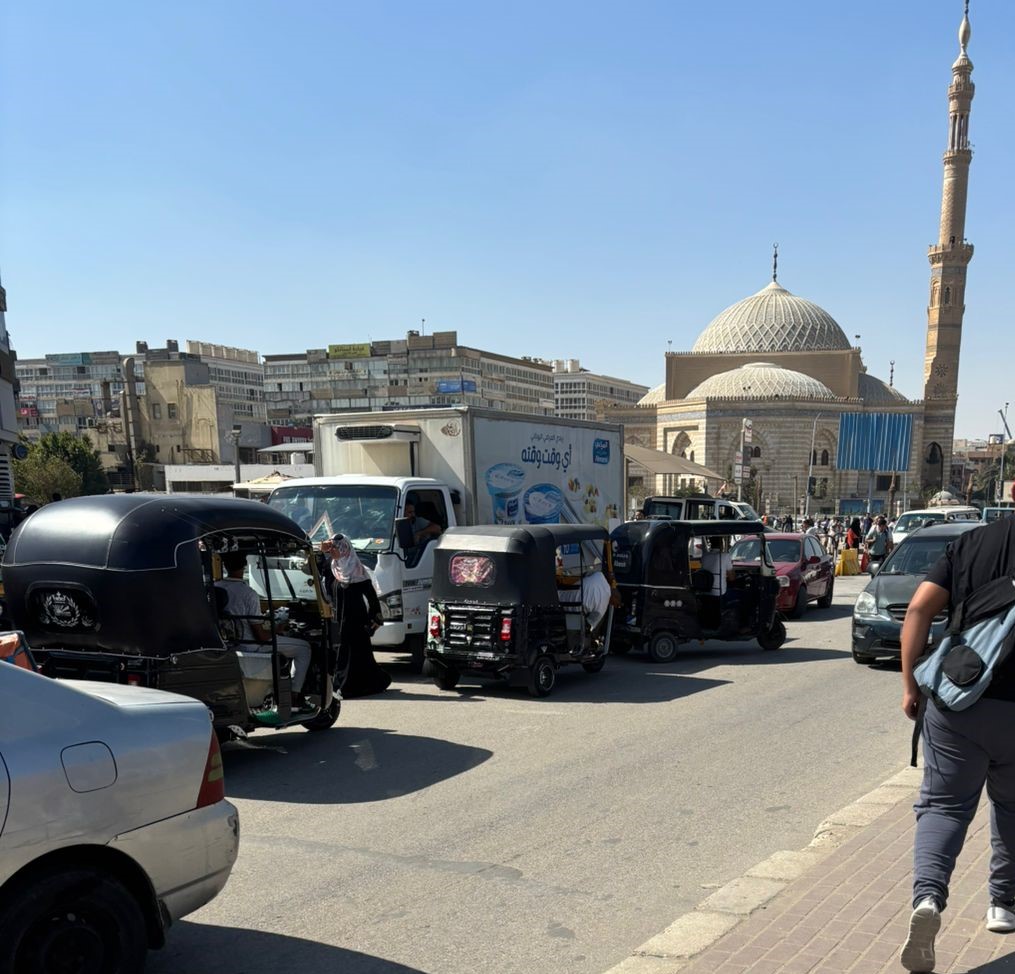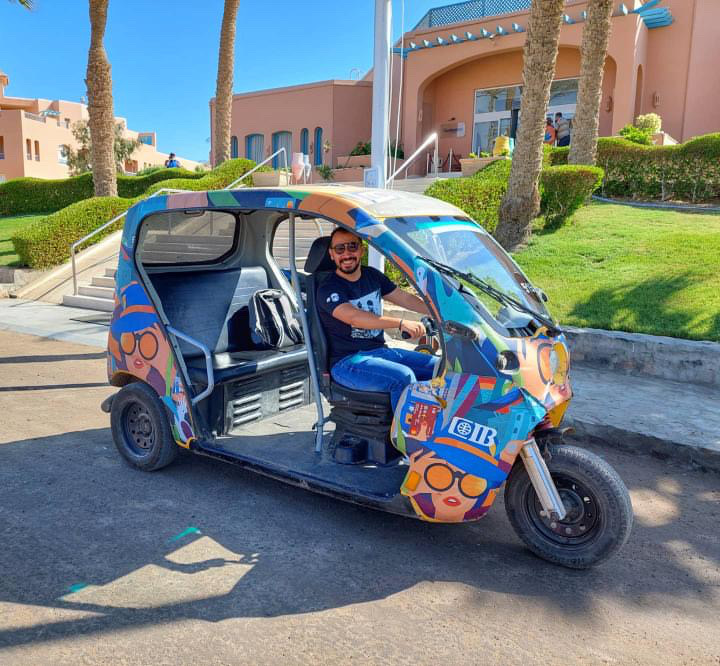
- Published on 22 October 2024
As calls to ban them increase, millions of households rely on tuk-tuks as a “last mile” mode of transportation, filling an important transportation gap at the local level. Are there ways to regulate tuk-tuks and make them a more humane means of transportation?[1]
Contents
What are the reasons behind the tuk-tuk’s popularity?
International Case Studies: Successful experiences with the tuk-tuk
A Case Study: El Gouna’s Successful Tuk-Tuk Integration
Introduction
In 2021, the Association of Tuk-Tuk Owners estimated that the number of tuk-tuks in Egypt had reached 5.4 million. However, official statistics from the Egyptian cabinet indicated that, as of mid-2021, there were only about 2.5 million tuk-tuks, with just 219,900 of them officially licensed by 2022. This significant discrepancy highlights a missed opportunity for the government to collect taxes. Moreover, the vast majority of tuk-tuks operate outside the state’s regulatory framework, leaving authorities unable to effectively respond in cases of accidents or crimes. Without license plates or proper identification documents, tracking down perpetrators involved in incidents becomes nearly impossible.
In response, the government has introduced several measures, including restricting the import of new tuk-tuks to limit their availability and attempting to replace them with minivans or similarly sized vehicles. Despite these efforts, the number of tuk-tuks has continued to grow. This raises critical questions: Why has the tuk-tuk become so widespread? And is banning it or replacing it with other modes of transportation truly a viable solution, especially for the broader public?
What are the reasons behind the tuk-tuk’s popularity?
It is not uncommon for non-users to mock tuk-tuks, wishing for their disappearance from the streets. However, what functional needs have driven the widespread use of tuk-tuks as a mode of transportation? To explore this, the study draws on personal experience, informal conversations, and direct interviews with users and drivers, along with media reports and academic research. The findings highlight the tuk-tuk’s role as a practical and, at times, indispensable component of transportation systems, despite its drawbacks and the challenges it poses for local residents. The study also examines how tuk-tuks adapt to various urban contexts and geographic areas, contributing to their extensive presence.
The advantages of the tuk-tuk
Availability and accessibility: When all other means of transportation are absent, you can count on finding a tuk-tuk
The tuk-tuk is readily available around the clock and can access a wide range of geographic areas, including remote locations lacking public transportation options like buses or subways. It also operates effectively in densely populated urban neighborhoods, where streets may be narrow, unpaved, or both, making them difficult to navigate for other forms of transportation, such as microbuses or taxis. This is particularly true in underserved areas and villages.
Tuk-tuks also serve as essential connectors, transporting passengers along routes that involve multiple modes of transit. They are often found clustered around metro stations or running along specific street networks that link designated stops or stations with nearby public bus stops, pedestrian bridges, or microbus stations, as illustrated in Figure 1. The absence of tuk-tuks in these scenarios creates challenges, especially given the long walking distances and streets that are not pedestrian-friendly. This is particularly problematic for navigating between inner streets and ensuring seamless door-to-door mobility, as shown in Figure 2.
Figure 1 shows the tuk-tuks heading to stations linked to a public transportation network in Ard El Lewa, Giza. The author.

Paradoxically, in newer settlements, where streets are paved and accessible to taxis and cars for hire through ride-hailing applications, tuk-tuks maintain their popularity. In comparison, other means of transportation are more costly and less available due to a weak demand resulting from a lower population density and higher rates of private car ownership, thus making tuk-tuks an ideal solution for those who do not own private vehicles, offering a more economical and faster alternative in access and transportation. Agencies governing new cities are moving towards banning tuk-tuks because, according to officials, they do not fit the “urban character” and are associated with “informal” areas, but tuk-tuks reappear in some of them, as shown in this picture in Figure 3. I asked some residents about the impact of the decision to ban tuk-tuks in “Haram Gardens” in a case where there was a strict policy banning them and replacing them with private cars or minis. The residents I talked to said that after two years of testing these alternatives, that compared to tuk-tuks the cost of the trip became unsustainable and did not bring the advantage of door-to-door delivery. New cities are not much different from unplanned areas in terms of poor coverage of the public transportation network, and as private mass transit networks such as the microbus or minibus attempt to fill this gap, residents and visitors alike find it difficult to walk, either because of the long distances between transit stations or the difficulty of walking on unshaded paths during the day or unoccupied paths at night.
Figure 2 shows the movement of tuk-tuks in internal streets where door-to-door access is available in Ard El Lewa. The author.

In rural areas, tuk-tuks play a significant role in social life and are widely used for short or long trips, family visits, and events. They not only serve as a crucial alternative to other unavailable modes of transport, but also help improve access to schools, hospitals, and other essential services in underserved areas located far from the majority of the village’s population. Tuk-tuks operate as a form of transportation similar to Uber and other ride hailing services and can be directly requested by contacting a driver known to the family.
Figure 3: Tuk tuks in 6th October City despite their ban. The author.

Problems with tuk-tuks
Driver behavior or weak regulation?
Official policies regarding tuk-tuks are primarily focused on addressing concerns about their “uncivilized appearance,” particularly when they appear in new cities. There is also a recent emphasis on the need to transition to clean energy and replace them with natural gas-powered vehicles. Despite the issuance of licensing laws[2], the majority of tuk-tuks remain unlicensed, and the number of licensed tuk-tuks is decreasing[3]. This means that riders are using vehicles that cannot be identified or reached in case of danger. Operating outside of regulation meant to ensure vehicle safety and test the driver’s competence, has led to an increase in accidents and other major incidents that have even involved kidnapping, theft, or murder in different areas, with no means of reaching the perpetrator.
With the low demand for licensing, local initiatives have emerged establishing an internal neighborhood-specific numbering system. Some local authorities and police departments have adopted these initiatives, such as in South Giza, Embaba, and in certain areas in rural governorates like Gharbia and Menoufia. However, this numbering system has not improved the experience of using tuk-tuks for daily commuters. There are three main issues that need to be addressed:
1) Fair ride tariff: Tuk-tuk trips are expensive in these areas, and drivers often follow an internal route that guarantees the shortest distance and the highest fare.
2) Safe routes and licensed drivers: Tuk-tuks are considered unsafe, particularly for women, and especially when passing through uninhabited areas that are devoid of public oversight. It is important to specify safe routes and ensure that drivers have valid driver’s licenses.
3) Designated tuk-tuk stations linked to public transportation networks: These stations should have traffic control and designated paths that don’t mix with pedestrian traffic.
The parallel system of numbering of tuk-tuks is mainly beneficial for authorities but does not offer much for passengers, since it fails to provide a system to report violations like with other modes of transportation. Aside from enabling unfair competition, tuk-tuks are left without measures to control and improve their performance, missing out on the potential for development. These challenges are exacerbated by limited regulatory traffic coverage, which usually only exists in city centers and formal neighborhoods with the necessary infrastructure for monitoring and regulation.
International Case Studies: Successful experiences with the tuk-tuk
Tuk-tuks are widely used across the Global South, spanning Asia, Africa, and South America. Known by various names—Autorickshaw in India, Tricycle in the Philippines, and Bajaj in Tanzania—they are simply called Tuk Tuks in Egypt, Thailand, and Kenya. Despite the regional differences in naming, their purpose remains consistent: providing short-distance transport in congested urban areas or remote regions with limited public transportation options. In India —where Egypt imported the tuk-tuk—, tuk-tuks are a popular and essential means of transportation, and efforts to regulate and improve their role in the transport sector date back to the 1988 Traffic Law, which recognized them as a form of informal public transport. The “Intermediate Public Transport” policy was later introduced to address growing transportation demands resulting from population increases. A study assessing the sector emphasized the need not only for better organization of tuk-tuks but also for more comprehensive transportation planning.
India and the Philippines have adopted various strategies to address challenges related to autorickshaws (tuk-tuks), similar to those in Egypt, and are based on best practices from various cities and states. These interventions have focused on:
- Enhancing safety for female passengers
- Strengthening rules and regulations
- Promoting environmental sustainability
- Improving overall public policies
These cases underscore the similarities between the Indian and Egyptian experiences in terms of issues and challenges faced. However, while Egypt places significant emphasis on the tuk-tuk’s impact on urban aesthetics, this concern is less prominent in India, where tuk-tuks have received considerable attention as an intermediate transport option, with numerous reports and studies highlighting its importance. The tuk-tuk has been supported by a variety of initiatives launched by both state governments and civil society, as well as banks, private sector companies, and entrepreneurs. These initiatives have primarily focused on maximizing the role of stakeholders and integrating them into the development of solutions tailored to the resources and facilities available to each party. Additionally, the presence of local governments, equipped with methodologies and tools to regulate tuk-tuks, has significantly improved their organizational structure. This is further reinforced by the vital role of regulatory bodies and professional associations.
A Case Study: El Gouna’s Successful Tuk-Tuk Integration
El Gouna, a recently developed mega tourism resort on the Red Sea in Egypt, stands out as a model for effectively integrating tuk-tuks into a formal transportation system. Unlike the semi-formal “tuk-tuk numbering” system used in other areas, El Gouna’s approach has elevated the tuk-tuk as a positive feature of the town, with vibrant vehicles that contribute to the city’s identity. The tuk-tuks in El Gouna offer several distinctive features:
– Bright, eye-catching colors that match the city’s aesthetic
– Licensed drivers
– Ride-hailing via a mobile app with predetermined fare prices
– Safety measures such as prohibiting passengers from sitting next to the driver and enforcing a speed limit of 40 km/h
Figure 4: A Gouna tuk tuk with distinctive livery. Ahmed Tarek (Maestro).

Proposed Recommendations
It is inevitable to integrate tuk-tuks into the formal transportation system. However, it is necessary to encourage alternatives to the tuk-tuk in order to foster competition, which would benefit users. It is also essential to evaluate the effectiveness and challenges of existing measures and to mitigate the potential risk of completely eliminating tuk-tuks from the transportation ecosystem. It is important to consider the livelihood of the workers in the tuk-tuk sector, which has provided essential or supplementary employment for many, despite the challenges it presents.
While there are many possible recommendations, this brief suggests focusing on overarching principles and broad strategies. From a policy and strategic perspective, it’s crucial to adopt a more holistic approach that does not only focus on one specific mode of transport. Instead, the goal should be to promote ease and equitable access to ‘last mile’ transportation—which is the short distance from a person’s starting point, like their home, to the nearest public transportation hub, and vice versa.
From a regulatory standpoint, existing policies targeting tuk-tuks suffer from significant shortcomings in both intent and implementation. The current framework falls short in engaging a broader range of stakeholders, including civil society, development organizations, private sector companies, and banks as key partners. Additionally, strengthening local governance structures is crucial, with a greater role for representatives from various ministries as implementation partners and system monitors.
Within this context, the transportation network reveals a broader mix of semi-formal and informal modes of transportation—such as microbuses and minivans— that are better organized than tuk-tuks, particularly in urban centers and newly developed cities. However, tuk-tuks often outperform other options, like deteriorating microbuses serving city outskirts and rural areas, or trucks converted into makeshift passenger vehicles. Embracing these insights allows us to explore and test new solutions, many inspired by successful international models (see Annex 1 for detailed examples).
Short-term recommendations:
- Develop localized digital platforms (for urban neighborhoods or rural districts) that register tuk-tuks and their drivers, ensuring they are licensed. The process should be simplified in coordination with relevant government authorities, who can also regulate the number of vehicles allowed in each administrative area (village, district, city, or center).
- Incorporate safety features into the platform to ensure secure rides, and set fair and transparent fare rates for passengers.
- Support the formation of unions and professional associations for tuk-tuk drivers to negotiate their rights and restore trust, which has been eroded by many policies targeting the informal economy.
- Partner with civil society organizations and the private sector to offer incentives, such as social and health insurance for drivers.
- Invest in infrastructure, including designated stations linked to the app, and improve the appearance of tuk-tuks to enhance both their aesthetic appeal and operational efficiency.
Medium-term recommendations:
- Expedite the codification of a new local governance law to reactivate local councils, enabling them to act as intermediaries for addressing any issues and improving ground-level operations.
- Develop a national strategy to improve public transportation, which includes integrating and upgrading tuk-tuks alongside other privately-owned transport modes like microbuses, minibuses, and taxis.
- Encourage the conversion of tuk-tuks to natural gas by expanding networks of fueling stations and offering tax exemptions and other incentives to drivers.
- Promote the manufacturing of alternative gas or electric vehicles with higher road safety standards, while ensuring these options meet the needs of diverse geographic areas and social groups.
Acknowledgements
Written by: Hanaa Gad
Reviewed by: Yahia Shawkat and Nadine Abd El Razek
Translated by: Nadine Abd El Razek
*The views expressed in this paper are those of the author and do not necessarily reflect the opinions of the Built Environment Observatory or its team.
Notes
[1] This study is part of the research explored in the researcher’s ongoing PhD dissertation, which focuses on Cairo as a more inclusive city that embraces diversity. It aims to apply and localize the principles of the “Inclusive City,” with an emphasis on unplanned areas and the promotion of their recognition within a broader framework that fosters integration into the city as a whole.
[2] Falling under Law 121/2008, amending certain provisions of Traffic Law 66/1973.
[3] The Central Agency for Public Mobilization and Statistics – Licensed Vehicles Bulletin (2020. 2021, 2022).
